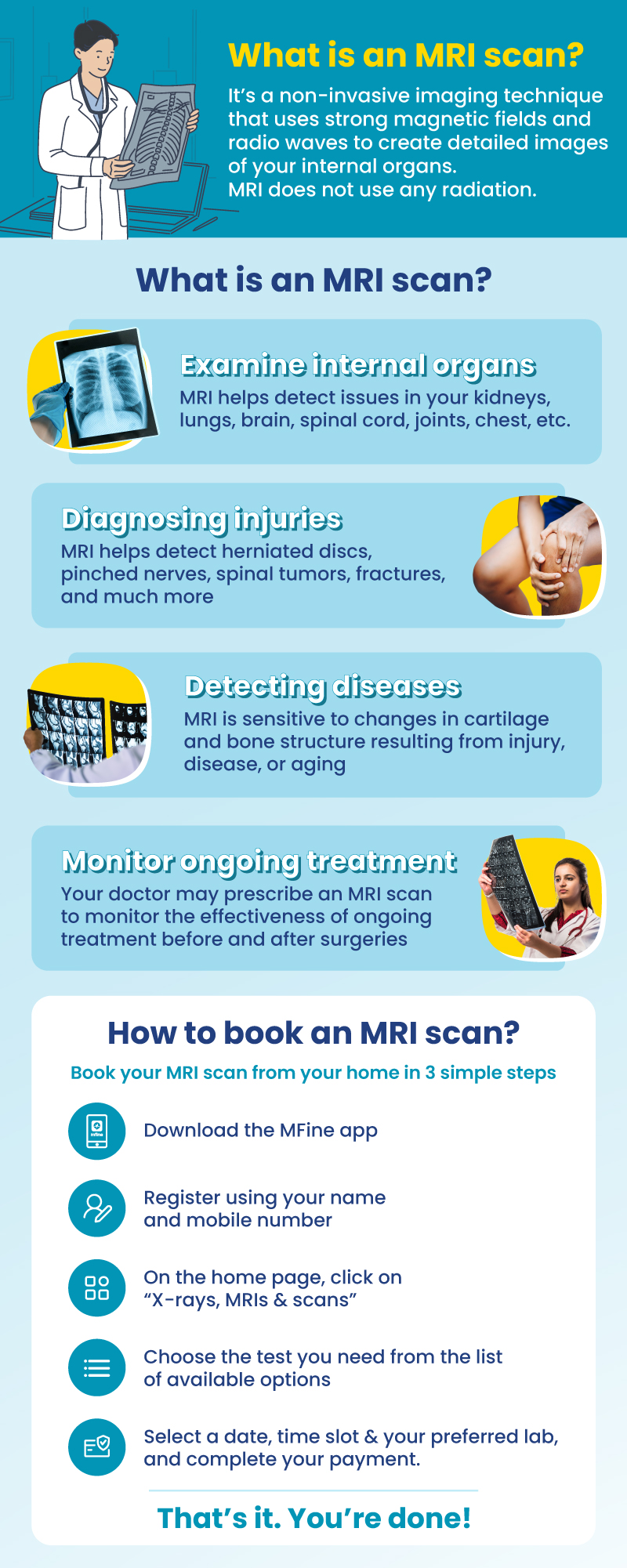
Don’t miss this chance to save big on Spine MRI scan costs in Chennai while still receiving top-quality lab facilities.
MFine offers you high-quality lab options, and an excellent discount of upto 50%, for your MRI Spine in Delhi.
MRI Scan Spine in Delhi by MFine
|
Looking to save on Spine MRI costs? The usual market rate is ₹ 7,000, but with our limited-time offer, it’s only ₹ 2,250—a huge discount of up to 50%!
Don’t delay; take control of your well-being now. Reach us at
Or use the button below to request a callback and book your scan!
Also, as a special bonus, we’re offering a FREE online consultation with a doctor when you book your MRI scan with us. This means you not only save on the scan cost but also receive expert medical guidance. Don’t wait, book now and enjoy the benefits!
Spine MRI scan costs in Delhi
Curious about the common Spine MRI scans offered in Delhi? Check out the discounted rates below. Remember that prices may fluctuate, so don’t hesitate to contact us for the latest updates.
| MRI Scan Spine Cost in Delhi | Offer Price |
| MRI Whole Spine Price in Delhi | ₹6600 |
| MRI Cervical Spine Price in Delhi | ₹2250 |
| MRI Dorsal Spine Price in Delhi | ₹2250 |
| MRI Lumbar Spine Price in Delhi | ₹2250 |
For further details, please contact us at ☏08061970525.
Why should I book MRI through MFine?
|
Exclusive Benefits with MFine
(1) Certified labs
Get access to over 600+ labs certified by NABL and NABH
(2) Same-day slot available
Get scans done on the same day
(3) Quick and convenient
Get reports in 12 hours and digital films in 15 – 20 minutes
(4) FREE Consultation
Post scans, consult a doctor for free to review your report
MRI of the Spine
Learn about the standard procedure of spine MRI, a diagnostic imaging test used to obtain detailed images of the spine and its adjacent tissues. The different parts and segments of the spine are:
Vertebrae: The 33 small bones that make up the spine are divided into five regions: cervical (neck), thoracic (upper back), lumbar (lower back), sacral (pelvic), and coccygeal (tailbone). Each vertebra has a unique structure and function, and they stack on top of each other, separated by intervertebral disks.
Facet Joints: Situated between adjacent vertebrae, the facet joints are small synovial joints that facilitate movement and flexibility in the spine. They allow for smooth articulation between vertebrae while minimizing friction during various movements, such as bending and twisting.
Intervertebral Disks: These flat cushions act as shock absorbers between the spine bones. Composed of a gel-like center (nucleus pulposus) and a fibrous outer ring (annulus fibrosus), intervertebral disks prevent the vertebrae from grinding against each other and help maintain the spine’s flexibility. However, they can be susceptible to herniation, a condition where the gel-like material protrudes and presses on nearby nerves, causing pain and discomfort.
Spinal Cord and Nerves: The spinal cord, a bundle of nerves, runs through the vertebral column’s central canal. It serves as a crucial communication pathway, transmitting sensory and motor signals between the brain and various parts of the body. The spinal cord’s protection within the bony vertebral column is vital, as any damage to it can lead to sensory or motor deficits.
Soft Tissues: Complementing the spine’s bony and nerve structures, soft tissues play a significant role in maintaining the spine’s stability and supporting its movements. Ligaments connect bone to bone, providing stability to the spine and preventing excessive movement. Muscles surrounding the spine help control posture, support the body’s weight and enable movement. Tendons attach muscles to bones, allowing for coordinated and controlled movements.

What are the different spine segments?
The different spine segments include:
- Cervical (neck): The uppermost segment housing 7 vertebrae (C1 to C7), facilitating neck mobility and safeguarding neural pathways.
- Thoracic (middle back): The middle portion with 12 thoracic vertebrae (T1 to T12), providing stability and protecting the chest area.
- Lumbar (lower back): The lower region comprising 5 vertebrae (L1 to L5), supporting the lower back and facilitating movements.
- Sacrum: A triangular bone formed by 5 fused sacral vertebrae connecting the spine to the hip bones.
- Coccyx (tailbone): The small, final section composed of coccygeal vertebrae located at the base of the spine.
Which disorders can be diagnosed using a spine MRI?
A spine MRI plays a crucial role in diagnosing an array of disorders, including but not limited to:
- Arthritis, particularly ankylosing spondylitis
- Back strains and sprains caused by injuries or overexertion
- Birth defects like spina bifida affecting spinal development
- Bone spurs, abnormal bony growths in the spine
- Curvatures of the spine, such as scoliosis and kyphosis
- Neuromuscular diseases like ALS (amyotrophic lateral sclerosis)
- Nerve injuries encompassing spinal stenosis, sciatica, and pinched nerves
- Osteoporosis, characterized by weakened bones
- Spinal cord injuries involving fractures, herniated disks, and paralysis
- Spine tumors and cancerous growths
- Spine infections like meningitis and osteomyelitis
Why would a doctor prescribe a spine MRI?
A spine MRI may be prescribed by a doctor for various reasons, such as:
- Diagnosis and evaluation of spinal conditions like arthritis, bone spurs, and curvatures (scoliosis, kyphosis).
- Assessment and monitoring of back injuries, including strains, sprains, and fractures.
- Investigation of nerve-related problems, such as spinal stenosis, sciatica, and pinched nerves.
- Detection and evaluation of spinal cord injuries, herniated disks, and spinal tumors.
- Diagnosis of infections like meningitis and osteomyelitis impacting the spine.
FAQs
Does an MRI show sacral nerves?
Yes, an MRI can show the sacral nerves and the surrounding structures in the sacral spine region. It can help identify any issues or abnormalities related to the sacral nerves, such as compression or impingement.
Read more on which is better: MRI or CT scan?
Does a sacral MRI show the tailbone?
Yes, an MRI of the sacral spine will typically include visualization of the tailbone (coccyx), as the sacrum and coccyx are adjacent and closely connected structures.
How long does a sacrum MRI take?
The duration of a sacrum MRI can vary, but it generally takes around 30 to 45 minutes to complete.
What scan is best for tailbone pain?
For tailbone pain, a coccyx MRI is the most appropriate imaging technique. It focuses specifically on the coccyx and surrounding structures to identify any issues or abnormalities that may be causing the pain.
What does a coccyx MRI show?
A coccyx MRI shows detailed images of the tailbone (coccyx) and nearby structures. It can help identify fractures, dislocations, tumors, infections, or other conditions that may be causing coccyx pain.
What kind of MRI is used for tailbone pain?
For tailbone pain, a coccyx MRI is used. It is a specialized MRI that focuses specifically on the coccyx and surrounding structures to evaluate the cause of the pain.
What are the 4 types of coccyx?
The four types of coccyx refer to the different configurations of the coccyx’s bone segments. They are:
- Type I: Consists of one large, triangular bone.
- Type II: Comprises two separate bones.
- Type III: Three separate bones.
- Type IV: Four separate bones.
These variations in the coccyx’s structure are normal anatomical differences.
How is coccyx pain diagnosed?
Coccyx pain is typically diagnosed through a combination of medical history, physical examination, and imaging tests. Imaging tests like X-rays or MRI may be used to visualize the coccyx and surrounding structures to identify any issues or abnormalities.
Is CT or MRI better for tailbone pain?
For evaluating tailbone pain, an MRI is generally considered better than CT. MRI provides superior soft tissue contrast, allowing for better visualization of the coccyx and nearby structures, which is essential for identifying the cause of the pain.
Is coccyx pain serious?
Coccyx pain can vary in severity and duration. In many cases, it is not serious and may resolve with conservative treatments such as rest, pain medications, and physical therapy. However, if the pain is persistent or significantly impacting daily activities, it is advisable to seek medical evaluation to determine the underlying cause and appropriate treatment.
What happens if your coccyx is damaged?
If the coccyx is damaged due to injury, such as a fracture or dislocation, it can result in pain, bruising, swelling, and limited mobility in the tailbone region. In most cases, coccyx injuries can heal with conservative treatments, but severe fractures or dislocations may require specialized medical attention.
What is coccyx surgery called?
Coccyx surgery is called a coccygectomy. It involves the surgical removal of the coccyx, typically performed when conservative treatments for coccyx pain have been ineffective and the pain significantly affects the patient’s quality of life.
Is MRI or X-ray better for bone?
For evaluating bones, X-rays are often the initial imaging choice, as they are faster, more readily available, and less expensive than MRI. X-rays are useful for detecting fractures, dislocations, and other bony abnormalities. However, MRI provides more detailed information about soft tissues, ligaments, and cartilage, making it more suitable for evaluating conditions that involve both bones and surrounding structures.
Is walking good for coccyx injury?
In most cases, gentle physical activity such as walking is beneficial for coccyx injury. Walking can promote blood flow to the affected area and help prevent stiffness. However, it is essential to avoid activities that exacerbate the pain and to follow the healthcare provider’s recommendations for rest and activity modifications during the healing process.
Other topics you may be interested in
| For further assistance call us on ☏08061970525 |

 Call us:
Call us:


 Call
Now
Call
Now